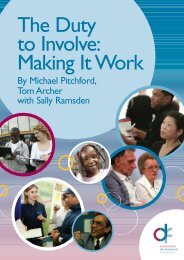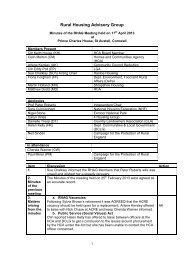Rapid Evidence Assessment of the Research ... - Rural Housing
Rapid Evidence Assessment of the Research ... - Rural Housing
Rapid Evidence Assessment of the Research ... - Rural Housing
You also want an ePaper? Increase the reach of your titles
YUMPU automatically turns print PDFs into web optimized ePapers that Google loves.
42.<br />
How have second homes been defined in <strong>the</strong> literature and what data sources have been used?<br />
The regulations also provide for one class <strong>of</strong> dwelling which is long term empty:<br />
Class C: Dwellings which are unoccupied and substantially unfurnished.<br />
43. Classes A and B define those dwellings for which billing authorities may reduce <strong>the</strong> Council Tax discount<br />
from between 50 per cent and 10 per cent (second homes), and Class C those dwellings where <strong>the</strong>y may<br />
reduce <strong>the</strong> discount from between 50 per cent to 0 per cent (long term empty homes).<br />
44. Councils compile information on <strong>the</strong>se categories <strong>of</strong> dwellings and this information is collated by <strong>the</strong> Office<br />
<strong>of</strong> <strong>the</strong> Deputy Prime Minister’s (OPDM) successor department, Communities and Local Government (CLG). In<br />
essence <strong>the</strong> Council Tax definition amounts to defining second homes as “furnished homes that are no-one’s<br />
main residence” (Gallent at al, 2005, p6).<br />
Definitions used in ONS Omnibus surveys<br />
45. The ONS Omnibus Survey, also known as Omnibus, is a regular, multi-purpose survey which started<br />
operating commercially in 1990. It was set up originally to meet <strong>the</strong> needs <strong>of</strong> government departments for a<br />
survey that used short and simple sets <strong>of</strong> questions, had greater statistical reliability than private sector<br />
omnibus surveys and a properly designed random sample.<br />
46. Omnibus surveys have, from time to time, been used to investigate second home ownership. The<br />
definitions used have however varied and <strong>the</strong> interpretation <strong>of</strong> <strong>the</strong> definition depends on both <strong>the</strong> questioner<br />
and <strong>the</strong> respondent. For example, in 1998 <strong>the</strong> Omnibus survey instructed interviewers as follows:<br />
47.<br />
“Please make sure that you do not include a caravan etc. or anything that is not a permanent structure as<br />
a second home. Most people with second homes are probably quite clear about which is <strong>the</strong>ir main home<br />
and which <strong>the</strong>ir second home (and, in general, we would expect <strong>the</strong> main home to be <strong>the</strong> one in which<br />
<strong>the</strong>y are interviewed). If respondents are in no doubt, let <strong>the</strong>m decide which is <strong>the</strong> second home. Some<br />
people may not feel sure (e.g. someone who spends 5 days a week in one place because <strong>of</strong> work and <strong>the</strong><br />
weekend in <strong>the</strong> family home). Where respondents are in any doubt please ask <strong>the</strong>m to treat as <strong>the</strong> main<br />
home <strong>the</strong> one which <strong>the</strong> household as a whole makes most use <strong>of</strong> and <strong>the</strong> o<strong>the</strong>r as <strong>the</strong> second home”<br />
(Omnibus, 1998; p6).<br />
In <strong>the</strong> July 2005 survey a test question for <strong>the</strong> 2011 Census was included. It asked:<br />
“Does anyone in your household own a second home?” Interviewers were instructed as follows: “A second<br />
home refers to any home <strong>the</strong> household rents or owns in addition to <strong>the</strong> home in which <strong>the</strong>y spend <strong>the</strong><br />
most time in or live with <strong>the</strong>ir immediate family” (ONS, 2005b, p99).<br />
48. This definition might be seen to include, unlike some o<strong>the</strong>r definitions, residences that are someone else’s<br />
main home. Thus buy-to-let properties owned by a member <strong>of</strong> <strong>the</strong> household would be included.<br />
49. This confusion might not be as great if a clearer distinction was made in general parlance between ‘home’<br />
and ‘house’ or ‘dwelling’. If a home is defined as something that cannot be built or bought or sold but is only<br />
created by <strong>the</strong> experience <strong>of</strong> living, <strong>the</strong>n households can own a second (or more) house or dwelling without<br />
owning a second home. In fact it is according to this approach impossible to own ano<strong>the</strong>r household’s ‘home’;<br />
it is only possible to own <strong>the</strong> house or dwelling in which ano<strong>the</strong>r household lives. Second homes <strong>the</strong>n become<br />
genuinely only places where a household creates a home in addition to <strong>the</strong>ir main home; but <strong>the</strong>y are also<br />
places that someone else has not made <strong>the</strong>ir home. There is, in short, an important distinction to be made<br />
between a house and a home.<br />
19






